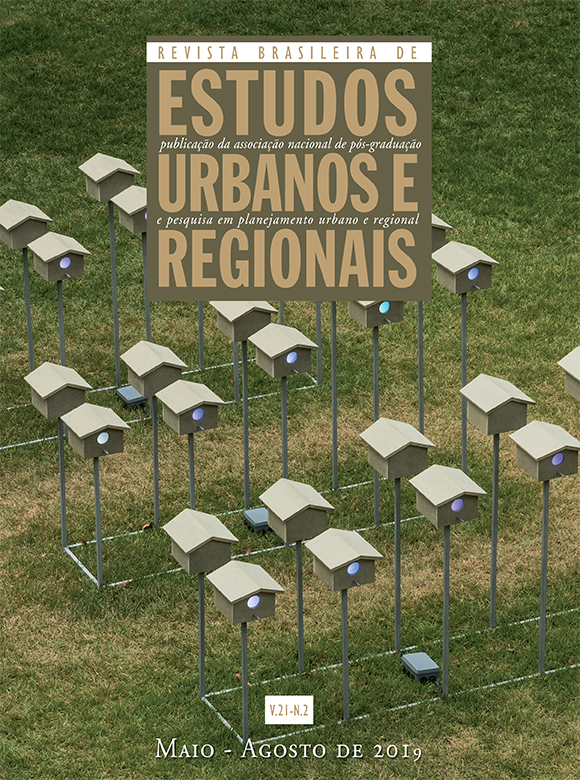The productive restructuring and consolidation of the new vectors of territorial development: the case of the Perimetrical Development Vector of the São Paulo Macrometropolis
DOI:
https://doi.org/10.22296/2317-1529.2019v21n2p312Keywords:
Productive corridor, Regional axes, São Paulo Macrometropolis, Productive restructu ring, Perimetrical Development VectorAbstract
This paper analyzes the conception of the Vetor de Desenvolvimento Perimetral (Peri
metrical Development Vector) of the São Paulo Macrometropolis as a linear axis of regional planning, which
has been privileged by the spatial reorganization of the productive structure of the State of São Paulo. Th
collected data demonstrates that the state planning agencies have made huge investments in the interregional
transport infrastructures, in order to provide this regional axis - between Sorocaba, Campinas, São José dos
Campos and the port of São Sebastião - with excellent conditions to attract the most modern sectors of contem
porary industry to the location, and thus consolidate it as the main corridor of production and flow of goods
related to the new industrial standards.
Downloads
References
BENKO, G. Economia, espaço e globalização na aurora do século XXI. São Paulo: HUCITEC, 1999.
CORDOVIL, F. C. D. S.; CESTARO, L. R. DAS UTOPIAS COMUNITÁRIAS À MODERNIZAÇÃO DOESTADO: O PLANEJAMENTO REGIONAL EM SÃO PAULO ENO PARANÁ, BRASIL, A PARTIR DA ATUAÇÃO DA SAGMACS (1950-1960). XIV Coloquio Internacional de Geocrítica, Barcelona, p. 1-26, 2016.
CORRÊA, R. L. Região e organização espacial. São Paulo: Editora Ática, 2000.
EMPLASA. Dinâmica da Macrometrópole - análise introdutória. Emplasa/Secretaria do Estado de Planejamento e Gestão/São Paulo [estado]. São Paulo. 1993.
EMPLASA. Emplasa 40 anos de planejamento metropolitano. Emplasa/Secretaria Estadual da Casa Civil/São Paulo [estado]. São Paulo. 2014.
EMPLASA. Plano de Ação da Macrometrópole Paulista 2013 : 2040 - O futuro das metrópoles paulistas. Emplasa/Secretaria Estadual da Casa Civil/São Paulo [estado]. São Paulo. 2015a.
EMPLASA. Plano de Ação da Macrometrópole Paulista 2013 : 2040 - Uma visão da Macrometrópole. Emplasa/Secretaria da Casa Civil/São Paulo [estado]. São Paulo. 2015b.
HAESBAERT, R. Região, regionalização e regionalidade: questões contemporâneas. Antares - Letras e Humanidades, jan./jun. 2010. 2-24.
HARVEY, D. A produção capitalista do espaço. São Paulo: Annablume, 2005.
LEITE, A. Polo Campinas-Sorocaba já é 2º maior PIB: Eixo conhecido por "corredor asiático" supera estados como Minas e Rio. Estado de São Paulo, São Paulo, 20 abr. 2013.
LENCIONI, S. O processo de metropolização do espaço: uma nova maneira de falar da relação entre metropolização e regionalização. In: SCHIFFER, S. (. ). Globalização e Estrutura Urbana. São Paulo: Fapesp/Hucitec, 2004.
NEGREIROS, R. Políticas de Crescimento da Macro Região e a Integração dos Modos de Transporte. Emplasa. São Paulo. 2010.
PROENÇA, A. Vetores urbano-regionais no Estado de São Paulo: O caso do Corredor Urbano Campinas-Sorocaba: Tese (Doutorado em Urbanismo). Campinas: Programa de Pós-Graduação em Arquitetura e Urbanismo, Pontifícia Universidade Católica de Campinas, 2019.
SANTOS, M. A urbanização brasileira. São Paulo: Hucitec, 1994.
SÃO PAULO (ESTADO). Abertura de túnel em serra marca nova etapa da duplicação da Tamoios, 2017. Disponivel em: <http://www.saopaulo.sp.gov.br/spnoticias/abertura-de-tunel-em-trecho-de-serra-marca-nova-etapa-da-duplicacao-da-tamoios/>. Acesso em: 16 fev. 2018.
SÃO PAULO [ESTADO]. Complexo Metropolitano Expandido de São Paulo - apresentação geral. Governo do Estado de São Paulo/Secretaria dos Transportes Metropolitanos/Emplasa - Empresa Metropolitana de Planejamento da Grande São Paulo SA. São Paulo. 2001.
SERRA, G. Urbanização e centralismo autoritário. São Paulo: EDUSP/Nobel, 1991.
SILVA NETO, M. L. D. Regionalização histórico-administrativa versus. X Encontro Nacional da Anpur, Belo Horizonte, 2003. 1-17.
Published
How to Cite
Issue
Section
Categories
License
Copyright (c) 2019 Revista Brasileira de Estudos Urbanos e Regionais

This work is licensed under a Creative Commons Attribution 4.0 International License.
Authors who publish in this journal agree to the following terms:
1) Authors who publish in RBEUR retain the rights to their work and assign to the journal the right to first publication, performed under the Creative Commons Attribution License that allows work to be shared and assures the recognition of authorship and of the original publication vehicle, to RBEUR.
2) Authors are free to assume additional contracts separately, for publication and non-exclusive distribution of the version of the work published in this journal (e.g., publishing in an institutional repository or as a book chapter), reaffirming the authorship and recognition of the original publication vehicle, to RBEUR.












.png)
